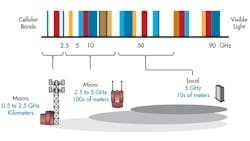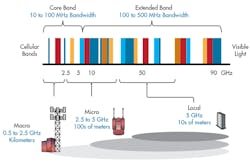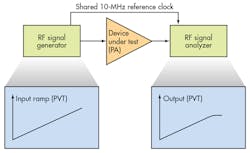The Top 6 Challenges for Signal Generators Handling LTE, Wi-Fi, and 5G
This file type includes high resolution graphics and schematics when applicable.
For signal generators, the latest wireless standards and technologies are once again demanding performance that is beyond the capability of standard instruments. For research and development (R&D), design verification testing (DVT), and manufacturing automation, for example, the latest standards features are requiring test and measurement instrument designers to dramatically increase modularity and bandwidth. Here are discussions of the six top challenges of wireless signal generation and how the latest signal generators are stepping up.
1. We need more bandwidth. In the mid-2000s, the bandwidth expectation was pushing the boundary with UMTS at 5 MHz. Only a decade later, the demands for LTE and IEEE 802.11ac leapt forward with requirements to 100 and 160 MHz, respectively (Figs. 1 and 2). As bandwidth climbed as a function of data demand on mobile devices, test and measurement companies began providing pre-release instruments until standard signal generators capable of those bandwidths were available—which was sometimes over a year. With 5G knocking on the door, there is again a significant demand for signal generators to exceed the bandwidths for current and later wireless standards.
According to Randy Becker, applications engineer for Keysight Technologies, “Key attributes for the next generation of wireless signal generators are wide bandwidths—up to a few gigahertz for future 5G applications—as well as the ability to simulate both multi-standard radios and a variety interference signals.” He added, “The highest-end signal generators will need to reach higher frequencies into the millimeter-wave bands, have multi-channel capabilities for MIMO/beam-forming applications, and advanced channel emulation for determining receiver performance in repeatable ‘real world’ conditions.”
A challenge with cranking up the bandwidth of signal generators is maintaining a flat frequency and phase response across the bandwidth. Maintaining solid frequency and phase performance goes hand in hand with providing the ability to modulate the latest wireless standards. Often, those standards have extremely narrow channel spacing and are susceptible to frequency and phase variations. For receiver testing, a signal generator also must maintain a very low noise floor and good voltage standing wave ratio (VSWR) in order to ensure accurate power of the applied signal. Thus, additional dimensions impact whether an instrument performs adequately over such a wide—and growing—bandwidth requirement.
2. Digital pre-distortion and envelope tracking require even more bandwidth. Adding another layer to the bandwidth challenge is the need for signal generators to implement power-amplifier (PA) efficiency-enhancing techniques. To reduce spurious emissions and reach greater linear PA response, methods like digital pre-distortion (DPD) are used. They correct for signal distortion at the output of the PA. Envelope-tracking (ET) techniques are often used in conjunction with DPD, raising the PA’s overall efficiency at the expense of increased complexity. Applying these techniques requires waveforms to be generated beyond the wireless standards’ bandwidth in order to use the full bandwidth of the standard.
“Having 100 to 160 MHz of bandwidth from the signal generator to test a mobile device has become fairly standard, though testing PAs is actually still a challenge,” said David Hall, marketing manager for National Instruments. “For example, many Wi-Fi PAs are now designed for use with DPD algorithms. As a result, in the IEEE 802.11ac case, the signal generator is required to supply a signal bandwidth that is higher than the 160-MHz channel bandwidth. In many cases, it is desirable for the signal generator to supply 2X to 3X the bandwidth of the channel—which is nearly 500 MHz in this case.”
The large amount of bandwidth required for generating these signals is derived from the DPD and ET signals’ need to include control of the modulated signal—control that will be achieved based upon distortion characteristics and the RF magnitude of the output signal. For ET and DPD, a lookup-table (LUT) of finite correction factors is used. This approach induces clipping at the lower boundaries that are acceptable in the LUT.
With significantly enlarged bandwidths, however, very precise time resolution is required to successfully implement these techniques. Often, designers must reduce the practical bandwidth of their tests to accommodate the limits of modern signal generators. This limitation may prevent these techniques from being viable for the highest bandwidths of IEEE 802.11ac and 5G until the signal generators’ performance can catch up.
3. Carrier aggregation, MIMO, and 5G require diversity and synchronization. Carrier aggregation (CA) requires that modulated signals be provided at various frequencies at the maximum bandwidth of an LTE channel. Using antenna diversity to increase data rate (such as with MIMO technology) requires modulated signals to be sent with a sophisticated layer of digital signal processing (DSP) over multiple antennas. Both of these techniques require multiple wide-bandwidth signal generators to transmit synchronized modulated signals. Understandably, the complexity and cost of synchronizing enough signal generators to realize a compound CA and MIMO system would scale with the number of carriers and antennas. With a full LTE-A implementation, for example, up to five carriers can be aggregated with a maximum of eight antennas, which would require tens of signal generators at substantial cost.
“Channel-to-channel synchronization and pure cost are some of the biggest challenges regarding MIMO testing,” noted Hall. “In order to test receiver performance under true MIMO conditions, engineers must be able to provide a multichannel stimulus to the DUT. Typically, this stimulus comes from multiple signal generators and requires clock signals like the local-oscillator (LO) and reference clocks to be shared.” Traditionally, this type of testing would require large numbers of costly rack-mount equipment, which would not be feasible for higher-order and massive MIMO technologies as they scale.
Hall continued, “Obviously, in addition to the synchronization challenges, MIMO test multiplies the number of required signal generators and can introduce a huge cost. Modular solutions, such as PXI, are actually an ideal solution to MIMO testing. Modular instruments enable each signal generator to share common clocks and timing signals through a common PXI backplane.”
Modular instruments packed with many multichannel signal generators can indeed tackle some of the latest wireless standard challenges. However, when introducing 5G and other future applications—such as massive MIMO—hundreds of channels may be required. The coherency challenges of synchronizing so many LOs and clock signals would be significant—especially when producing a test setup that wouldn’t be on-par with a supercomputer mainframe in terms of cost and complexity. Yet signal generators designed on extremely integrated and modular platforms may be the only recourse, considering that 5G could reside in the upper microwave bands and use advanced beamforming techniques with active electronically steered arrays (AESAs) of antennas (Fig. 3).
This file type includes high resolution graphics and schematics when applicable.
Getting in Sync
This file type includes high resolution graphics and schematics when applicable.
4. Wireless test requires generator and analyzer synchronization. In the testing of wireless devices, many instruments are used to measure the behavior of a passive or active component. Signal generators come into play when those components need to be tested using “real-world” signals. In contrast, signal/spectrum analyzers are used to measure component response (Fig. 4). Naturally, these instruments require synchronization. For the latest modulation techniques, they also may need to communicate and coordinate their operation. For automated manufacturing test, this process needs to be performed rapidly—wasting as little time and requiring as little intervention as possible.
“With a signal generator and signal/spectrum analyzer integrated into the same instrument, functionality opens up to test both the receiver and transmitter at the same time,” said Becker. “Such an instrument enables new tests like ping-ponging and pipelining as well as system calibration—including the effects of the test fixture. Another advantage is the ability to respond to feedback from the DUT.”
With built-in automatic feedback, an integrated signal-generator-signal/spectrum-analyzer can rapidly complete test routines and system calibrations while providing higher performance, thanks to the enhanced synchronization. Becker continued, “As an example, an LTE base-transceiver-station (BTS) conformance test that requires hybrid automatic repeat request (HARQ), acknowledge/no-acknowledge (ACK/NACK), and timing adjustment feedback can automatically adjust the characteristics of the transmitted signal based on the receiver behavior.”
5. Theoretical and proprietary research requires flexibility. With wireless standards constantly evolving, a signal generator may quickly become obsolete as wireless standards incorporate new techniques and modes. In many research environments, multiple wireless standards may be of interest as well. Yet the cost of purchasing several instruments just to provide experimental justification for a wireless standard may not be in the budget. The customization of software-based signal-generator platforms may enable users to program their own waveform techniques. Yet self-creating and maintaining in-house software for the latest standards can be unacceptably time-consuming and resource-intensive. Many of the latest test instruments mitigate some of this challenge by building in the latest wireless standards, which can then be accessed using a simple soft-key.
“For signal generators not to be a limiting factor in wireless testing, they will need to become more flexible, as new and unforeseen needs will come along with future standards,” noted Becker. “Field upgradability is also important alongside software with standards-compliant applications and the ability to custom-generate proprietary formats in the research phase.”
While the performance specifications of modern signal generators remain critical, wireless testing has become so complex that raw performance is on par with the instrument’s software features and configurability. To tackle the need for on-demand upgrades with the latest wireless standards, many test and measurement companies are including the ability to upgrade an instrument to the latest standards installments with a simple downloadable program or remote connection.
6. CPUs go out of style. Hardware obsolescence is one of the greatest challenges faced by equipment users in any technology field. Obviously, obsolescence makes maintaining precision test equipment difficult. It also means engineers must settle for using less optimal instruments for longer periods of time. In R&D and automated manufacturing test, this factor can increase costs and time for both developing and producing devices. With signal generators for wireless test in particular, the latest modulation techniques and waveforms could require more significant computation and DSP performance, which is often well beyond what present central processing units (CPUs) and field-programmable gate arrays (FPGAs) can handle. Modular and software-based instruments offer a partial solution to preventing an accumulation of costs and outdated equipment. Compared to traditional benchtop instruments, they often have components that can be more cheaply and rapidly replaced.
“Another key characteristic of synthetic/modular instruments is the interchangeability of the CPU,” said Hall. “In my opinion, the interchangeability of the CPU is one of the most important—yet underrated—benefits of PXI. In fact, CPU performance is the single biggest contributor to measurement speed.”
A significant drawback of many prior big-box instruments was that custom designs incorporated the CPU. This approach prevented upgrades and relegated an instrument to being obsolete in a few short years. According to Hall, “Many engineers using PXI instruments in an automated wireless test application can improve test time simply by upgrading the PXI controller. Because CPUs generally improve by 20% to 25% on an annual basis, maintaining the latest CPU is a great way to optimize measurement speed.”
This file type includes high resolution graphics and schematics when applicable.
About the Author
Jean-Jacques DeLisle
Jean-Jacques graduated from the Rochester Institute of Technology, where he completed his Master of Science in Electrical Engineering. In his studies, Jean-Jacques focused on Control Systems Design, Mixed-Signal IC Design, and RF Design. His research focus was in smart-sensor platform design for RF connector applications for the telecommunications industry. During his research, Jean-Jacques developed a passion for the field of RF/microwaves and expanded his knowledge by doing R&D for the telecommunications industry.





